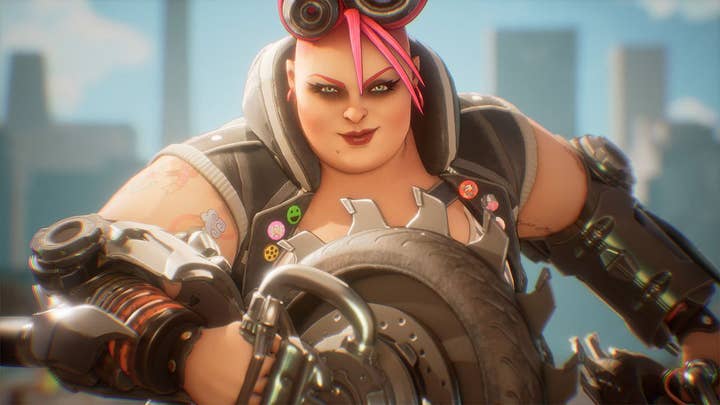The Bleeding Edge of multiplayer design
Creative director Rahni Tucker on how the Xbox brawler will ensure Ninja Theory keeps one foot in the action genre
There's no denying Hellblade: Senua's Sacrifice did wonders for Ninja Theory's reputation.
The game, which explored mental health issues in a dark fantasy adventure, garnered widespread critical acclaim, sold more than one million units in its first year, and picked up five BAFTA awards -- not bad for a title with a lower development budget than might be expected from a studio with such AAA pedigree.
Ninja Theory is, understandably, building upon the game's impact with a sequel and a new R&D project that will create game experiences designed to help people identify and control negative emotions such as anxiety and fear. Just this week, the studio has announced Project Mara, a new title designed to be "a real-world and grounded representation of mental terror."
But at least one team within the company is staying true to the Cambridge-based developer's roots. Drawing on its experience making titles such as Heavenly Sword, Enslaved, and DmC: Devil May Cry, the studio is also working on Bleeding Edge, a online multiplayer brawler for Xbox.

"Ninja Theory has a great heritage with third-person action combat and for me specifically that's what I like to make, what I like to work on," creative director Rahni Tucker tells GamesIndustry.biz.
"When I first thought of the idea, I was like, 'Why doesn't this exist?' It feels like it should. We put a really small team together, started prototyping some ideas and experimenting to see whether the idea would actually work. And it did, so we made the game."
The Bleeding Edge team has averaged around 15 people over the course of its development, peaking at 25, which Tucker tells us is "only about a quarter of the studio." Tucker says the contrast between this game and the likes of Hellblade or Project Mara is more a comment on the differences between herself and co-founder Tameem Antoniades as creative directors, rather than on the direction of the company.
"Tameem was the creative director on all of the other Ninja Theory titles," Tucker said. "He directed Hellblade and he's got really great expertise with character, exploring narrative and that sort of thing -- that's what he likes to do. For me, personally, I like the mechanics a bit more, I like more 'gamey' games, more fun games, so it's just a matter of passion and what we each like to work on."
She continued: "The original premise of having this third-person melee action with team multiplayer was just something I hadn't seen, and I felt like that was enough of a difference to anything else to have something special. When you play the game, you really feel the difference between Bleeding Edge and other stuff in the space. It's not really the same as anything else -- at least that I've played."
"In a single-player game, you can run around and kick the arse of 100 guys, be a god basically - that doesn't work for multiplayer"
Tucker certainly has identified a gap in the market. Despite the market being dominated by multiplayer games, perhaps Ubisoft's For Honor (with its focus on melee combat) is the only current comparable title. Platinum attempted this formula with MadWorld's spiritual successor Anarchy Reigns, but the game never took off. The same can be said for Bandai Namco's Rise of Incarnates, which shut down after just a few months.
The struggles for this type of experience seem odd, however, given how abundant third-person combat is across console games. Are multiplayer melee brawlers more complex than shooters and other genres?
"It's hard, that's for sure," Tucker admits. "We had to completely replace the networking layer in Unreal, so our extremely smart lead coder figured out how to do a team multiplayer rollback engine. That's a big part of what makes the game feel right, because you don't have that input latency when you press the buttons. That's super important for third-person combat, that you're not pressing the button and waiting for the message to come back before the guy starts animating.
"The other problem is making sure it's fun for the guy being hit. Being in a single-player third-person action game, you can run around and kick the arse of 100 guys, be a god basically -- that doesn't work for multiplayer. It's not very fun being the one stuck in a 100-hit combo so we're trying to find that balance between making it fun and rewarding for the attacker but also giving counterplay to the guy being comboed."
She points to a series of design decisions that enable that counterplay. Every character has an evade move, although this is controlled by a stamina bar "so you can't just spam evade and be invincible." Some have extra movement abilities, such as a jump pad or nitro boost, to get them out of trouble. Many of the most powerful moves have brief "super frames" of animation where the character can't be interrupted. And teammates can (and hopefully will) come to stricken players' rescue.
Bleeding Edge also stands out with its colourful art style and outlandish characters, which was inspired by a mix of comics and anime such as Akira, Ghost In The Shell and Tekkonkinkreet. Tucker says she "wanted to make it feel like playing a graphic novel."
"We have a really diverse team and that helps, that just naturally culminated in a diverse roster of characters"
The art direction also compliments the diverse cast of characters. The roster offers more than the muscle-bound men and slender women that have traditionally led character design in video games, instead featuring an array of body types and races. Examples range from Māori character Makutu to plus-size woman Buttercup, a character Tucker is particularly proud of.
"She's awesome. She was the first character we made," she says. "I don't know [why we started with her]. She was just the first character that came together, where we were like, 'Yes, that's it, that represents what we want to do with the game.' We wanted every character to feel like they could be the protagonist of their own game. If you wanted to, you could go and do a single-player spin-off with any one of these characters and they would be interesting enough and have enough personality that people would be interested in it. We didn't want there to be a main character and a bunch of back-ups.
"We have quite a long design process. Our team's pretty small, but pretty much everyone jumps in when it comes to designing characters. Sometimes they start with a gameplay idea, sometimes they start with a cool idea. Nidhogger started as 'Well, he's a black metal guitarist from Norway, so let's design around that and see what we can come up with.' Then we try to put a little twist on it to make it a little bit crazy, a little bit different, something you don't quite expect from the character."

The industry is slowly doing more to represent a broader range of people. Blizzard, for example, made a point of emphasising that Overwatch's cast would have a big focus on diversity, a value the company continues to work on today. Was there a conscious effort to design around a similar philosophy on Bleeding Edge?
"We just wanted to design cool characters," she says. "It's not something we decided to do at the beginning or anything like that. We have a really diverse team and that helps, that just naturally culminated in a diverse roster of characters. Because everyone that's putting into it, we're from all over the world, all different ethnic backgrounds, different ideas and ways of life. When that comes together in the game, it just happened that way. It wasn't a plan, but I like that it's there."
Bleeding Edge launches for Xbox One, Windows, and (of course) Game Pass on March 24th. Development has been heavily informed by the technical alpha that has been running since June, with two technical betas set to take place between now and release. Interestingly, the title's inclusion in Game Pass has actually steered the direction in a way that developers have rarely discussed so far.
"There's a fair bit of focus at the moment on the new player experience," Tucker explains. "Coming to Game Pass changes things a little bit compared to if we were selling the game outright. If people go out and spend a bit of money on a game, it's probably because it's in a genre they know and understand so they're going to have familiarity with things like objective control or class-based characters.
"But if you've come to the game through Game Pass and maybe you don't know so much about this type of genre, it can be a little harder to get into the game. Maybe they don't know all of the buttons, maybe they don't know how the game modes work, so we're trying to focus on that and make sure there's a nice ramp for new players coming into the game. They can practice safely in the tutorial and in the Dojo against AI, warm up to the game and start to understand why the team is important and what you can do as an individual. Hopefully they can go into that first game a little bit more prepared."










